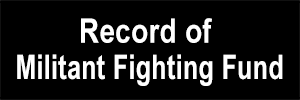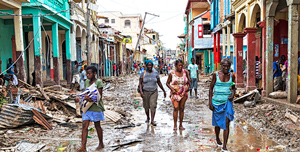There are more than 1,000 dead and still counting in Haiti, a capitalist country dominated by U.S. imperialism. In revolutionary Cuba, while thousands of homes and acres of forests and crops were destroyed, there was not one single fatality. In the United States, at least 23 people are dead as of Oct. 10.
In the midst of its own challenges in repairing the storm’s destruction, Cuba sent reinforcements to Haiti to join its medical mission there to combat cholera and other diseases in the wake of the storm.
Matthew hit both Haiti and Guantánamo province in Cuba Oct. 4 as a Category 4 hurricane. In the costal town of Baracoa, “the waves reached the second floor,” one resident told Juventud Rebelde. Some 90 percent of homes were damaged in that town of 60,000.
The Cuban leadership started organizing well before the hurricane made landfall.
On Oct. 2, President Raúl Castro began a several-day tour of Guantánamo. He participated in a meeting of the Provincial Civil Defense Council, which oversees disaster preparedness, “focused on protecting the population and minimizing economic losses.” Castro and the council set up camp in nearby Santiago.
According to Juventud Rebelde, the Civil Defense, working together with local government and army personnel, evacuated more than 1 million residents. Some 372,885 people were placed in shelters and another 944,886 moved in with family, friends and neighbors.
Reconstruction begins immediately
Brigades of electrical workers and soldiers armed with buzz saws were sent to the region before the hurricane hit — anticipating that roads and bridges would be washed out — to make sure repairs could begin immediately.“We’re here to help the recovery,” utility worker Ismael Infante, who came from neighboring Tunas province before the storm, told EFE news service.
Repair and recovery work began as soon as the winds died down. It looked like a sea of olive green, wrote a Juventud Rebelde reporter arriving in Baracoa Oct. 8 by helicopter. He referred to the hundreds of soldiers mixed in with town residents who were working to clean up roads and get reconstruction going.
“The most important thing is that there was not a single death,” Castro told a crowd of hundreds when he toured Baracoa that day.
The government announced Oct. 8 that supplies to rebuild homes would be sold at half price and that low- or no-interest, long-term loans were available to anyone who needed them. Those most in need will be given the materials free of charge.
Mass organizations, including Committees for the Defense of the Revolution and the Union of Young Communists are organizing volunteers such as carpenters, bricklayers, plumbers and anyone who wants to travel to the most affected areas to work side by side with residents to rebuild their homes.
“It won’t be quick, but we are going to recover,” Noel Mosqueda, president of the Municipal Defense Council in Maisí, told Juventud Rebelde.
In U.S., Haiti ‘You’re on your own’
Unlike Cuba, the governments in both Haiti and the United States took the approach of “every man for himself.”As the storm approached Florida’s east coast Oct. 6, Gov. Rick Scott announced, “You need to leave. Evacuate, evacuate, evacuate.” The governors of South Carolina and North Carolina made similar statements.
While some buses were organized to evacuate people, most were left to fend for themselves. USA Today reported Oct. 6 that those who tried to flee in Florida “faced clogged roads, dwindling fuel supplies and sold-out hotel rooms.” Despite the clogged roads and gas shortages, Mayor Eddie DeLoach in Savannah, Georgia, warned anyone who decided to ride out the storm, “Do not expect us to be there to help you.”
The latest destruction in Haiti adds to the devastation from the 2010 earthquake and subsequent cholera epidemic that left more than 300,000 dead.
The government took almost no measures to evacuate or get people to shelters before the storm. According to the aid group Mercy Corps, more than 80 percent of the crops that feed 20,000 families were destroyed in the hard-hit southern part of the island.
Farmers near St. Louis-du-Sud told Reuters that the area’s wooden boats, used to catch fish and shrimp, were destroyed. Little aid is arriving from around the world. Along with looming food shortages from the destruction of crops, livestock and farm and fishing implements — no small matter in Haiti, one of the poorest nations in the world — is the danger of a new rise in cholera.
Reuters reports that at the Port-a-Piment hospital alone, the number of cholera cases jumped from 13 before the hurricane to nearly 60 on Oct. 9. “We have been abandoned by a government that never thinks of us,” said Marie-Ange Henry in the village of Chevalier.
On Oct. 8, 38 doctors, nurses and specialists in control of epidemics flew from Cuba to Haiti to strengthen the efforts of 648 Cuban internationalist medical volunteers already stationed there. Cuban volunteers played a key role in controlling the cholera epidemic after the 2010 quake.
“We are going to Haiti with the same combativity with which our co-workers are working in the eastern provinces affected by the hurricane, as an example that we share what we have,” said Alexis Diaz Ortega, head of the brigade.
“Ever since we were little we wanted to be like Che [Guevara],” Dr. Nevis González told Prensa Latina. “In this mission we will be a worthy example of that,” by saving thousands of lives.
Related articles:
Cuba is example for workers worldwide
|
Printer-friendly version of this article |








 click here for information and literature from the Socialist Workers Party 2016 campaign
click here for information and literature from the Socialist Workers Party 2016 campaign a magazine of Marxist politics and theory from 1934 to the present
a magazine of Marxist politics and theory from 1934 to the present an international news magazine published from 1963 to 1986
an international news magazine published from 1963 to 1986 issues of the monthly Spanish-language socialist magazine from 1999 to 2005
issues of the monthly Spanish-language socialist magazine from 1999 to 2005





